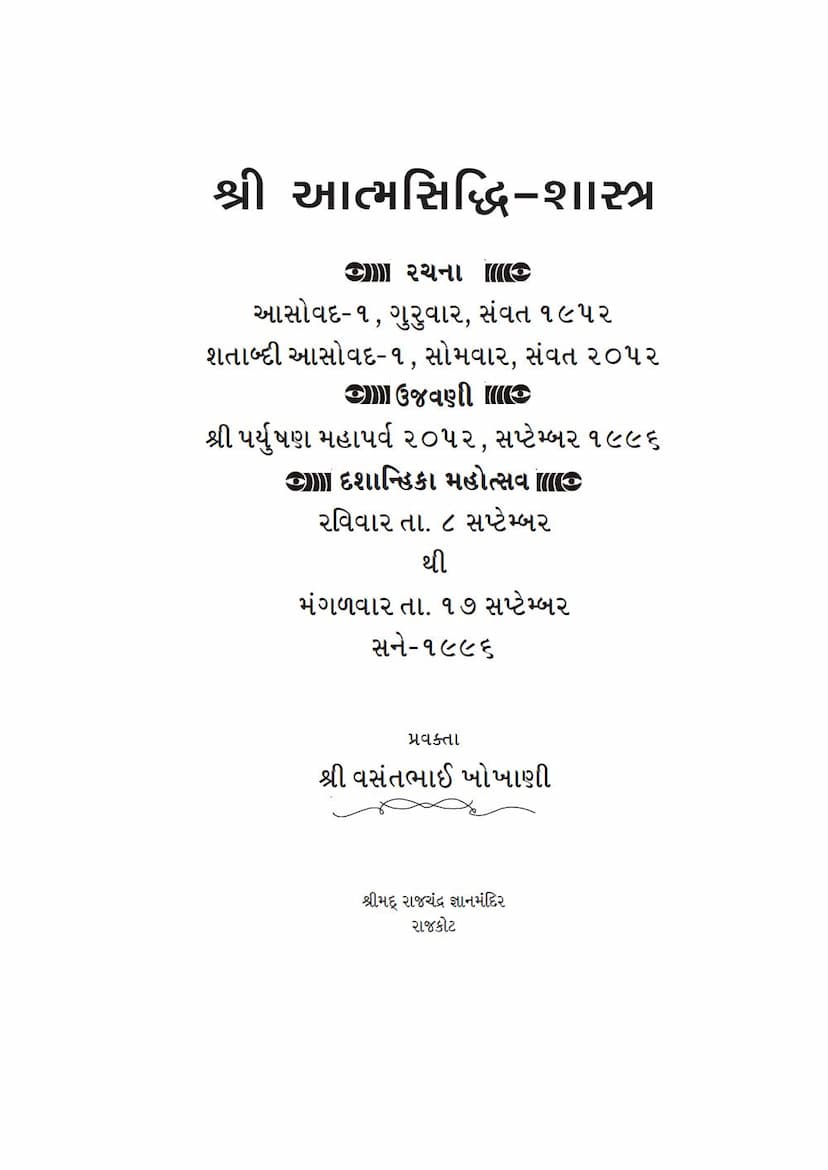Aatmsidhi Shastra
Added to library: September 1, 2025

Summary
Here's a comprehensive summary of the Jain text "Aatmsidhi Shastra" by Vasantbhai Khokhani, based on the provided pages and catalog link:
Title: Shri Aatmsidhi Shastra Author: Vasantbhai Khokhani Publisher: Shrimad Rajchandra Gyanmandir, Rajkot Catalog Link: https://jainqq.org/explore/034356/1
Overview:
"Shri Aatmsidhi Shastra" is presented as the essence of all scriptures, the distilled knowledge of Tattvajñāna (the knowledge of reality), and the hidden path to Moksha (liberation) as taught by the Vitaraga (those devoid of attachment and aversion). The text is a commentary or discourse on the original "Aatmsidhi Shastra" (also known as "Chh Pad Patra" - the letter of six verses) composed by Bhagwan Shrimad Rajchandra. It was delivered by Shri Vasantbhai Khokhani, a respected scholar and preacher in the Jain tradition. The publication is a testament to the enduring relevance and profound impact of Shrimad Rajchandra's teachings.
Origin and Context:
The original "Aatmsidhi Shastra" was composed by Bhagwan Shrimad Rajchandra in just over an hour in Nadiyad, Gujarat, in response to a request from his close associate, Shri Sobhagbhai. Sobhagbhai found it difficult to memorize the six verses of the "Chh Pad Patra" and requested it in a more accessible, poetic form. Bhagwan Shrimad Rajchandra, with immense compassion, granted this wish, bringing forth the "Aatmsidhi Shastra" as a means to uplift fallen souls. The text itself is considered a sacred river, the Ganga from the heavens, for the purification and upliftment of those seeking spiritual liberation.
Key Themes and Content:
The "Aatmsidhi Shastra" is structured as a dialogue between a disciple (Shishya) and a preceptor (Sadguru). The disciple, filled with sincere doubt and seeking the ultimate truth, poses various questions, and the Sadguru systematically addresses them, guiding the disciple (and the reader) towards the understanding of the soul and the path to liberation.
The text covers fundamental Jain philosophical concepts, including:
- The Nature of the Soul (Aatma): It begins by establishing the existence and nature of the soul, addressing the disciple's initial doubts about its imperceptibility and lack of form. The Aatma is described as eternal, the knower of all, and distinct from the body, senses, and breath.
- The Six Fundamental Principles (Shatpad): The core of the "Aatmsidhi Shastra" is the explanation of the six fundamental principles of Jain philosophy, which are presented as the essence of the path to liberation. These principles are elucidated through the disciple's questions and the Sadguru's detailed answers. The six principles discussed are:
- Aatma exists: Affirming the existence of the soul.
- Aatma is eternal: The soul is not subject to birth or death.
- Aatma is the doer of its own Karma: The soul is responsible for its actions.
- Aatma is the enjoyer (bhokta) of Karma: The soul experiences the fruits of its actions.
- Moksha exists: Liberation from the cycle of birth and death is possible.
- Moksha is achieved through Dharma (Righteousness/Path): The path to liberation is through right conduct and knowledge.
- Addressing Skepticism and Doubt: The text masterfully tackles common philosophical doubts and misunderstandings. It systematically refutes the idea that the soul is identical with the body, senses, or breath, and addresses the apparent lack of sensory perception of the soul. It also clarifies the concept of eternity versus impermanence, and the soul's role as both the doer and enjoyer of karma.
- The Importance of the Sadguru: The text consistently emphasizes the indispensable role of a Sadguru (True Preceptor) in the spiritual journey. It highlights that true knowledge and the path to liberation can only be understood and realized through the guidance of a realized soul. The Sadguru's teachings are presented as the ultimate remedy for the disciple's doubts and ignorance.
- Rejection of Mere Ritualism and Dry Intellectualism: The commentary, as delivered by Vasantbhai Khokhani, implicitly (and the original text explicitly) warns against two common pitfalls: "Kriya-jad" (being stuck in mere rituals without inner understanding) and "Shushk-jnani" (having dry intellectual knowledge without inner realization or practice). True spirituality lies in the integration of knowledge and practice, driven by genuine inner transformation.
- The Nature of Karma and Liberation: The text delves into the nature of karma, how it binds the soul, and how its effects are experienced. It explains that liberation (Moksha) is not an external grant but an internal realization achieved by shedding the karmic coverings through right knowledge, right perception, and right conduct.
- The Role of Discrimination and Understanding: The discourse stresses the importance of understanding "where and what is appropriate" (જ્યાં જ્યાં જે જે યોગ્ય છે, તહાં સમજવું તેહ). This implies discerning the true nature of things and acting accordingly, applying knowledge with wisdom and discretion.
- Emphasis on Inner Transformation: The teachings underscore that the ultimate goal is not external adherence to rules but the inner transformation of the soul. This involves purifying the mind, cultivating virtues like dispassion (vairagya), detachment, and equanimity.
Commentary by Vasantbhai Khokhani:
Vasantbhai Khokhani's delivery is described as captivating, profound, and filled with devotion. He brings a deep understanding and expansive knowledge to the text, making complex philosophical concepts accessible to the audience. His discourses have benefited thousands of spiritual seekers in India and abroad. The publication of these discourses acknowledges his dedication and love for the teachings of Shrimad Rajchandra.
Publication Details:
The book is a publication of Shrimad Rajchandra Gyanmandir, Rajkot. The first edition was released on November 4, 2017. The text is made available for private and personal use by Jain Education International.
Overall Significance:
"Aatmsidhi Shastra" is a cornerstone of Jain spiritual literature, offering a clear, logical, and practical path to self-realization and liberation. Bhagwan Shrimad Rajchandra's ability to convey profound truths in simple, accessible language, and Vasantbhai Khokhani's masterful explanation of this text, make it an invaluable resource for anyone seeking spiritual understanding and liberation from the cycle of existence. The text emphasizes that true spiritual progress comes not from mere intellectual pursuit but from a sincere quest for self-knowledge and adherence to the path illuminated by the Sadguru.